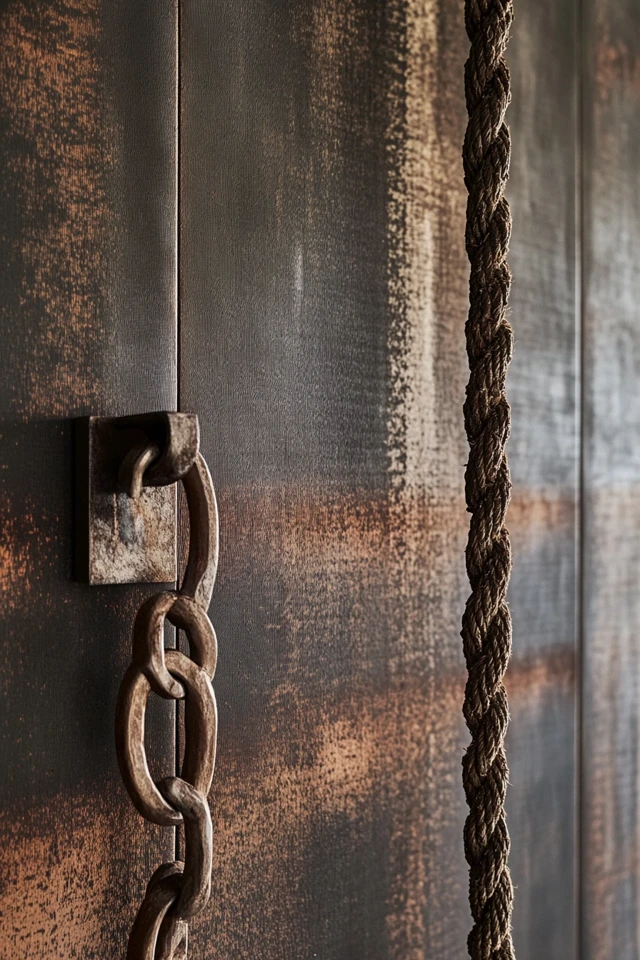Introduction
I’ll never forget the first time I used rope and chains in an interior design project. It was for a client who wanted to transform their dining room into a space that felt straight out of an old factory—raw, authentic, and industrial. We decided to incorporate black steel chains to suspend pendant lights over the table and used thick jute rope as curtain tiebacks. The result? A design that was striking, unconventional, and filled with character. It was my first lesson in how these unexpected materials can elevate industrial interiors.
Rope and chains may seem like unusual choices for interior design, but in the world of industrial style, they’re absolute gems. Their rugged texture and utilitarian aesthetic fit perfectly with industrial interiors, which celebrate raw materials and functional design. Whether used for lighting, shelving, or decorative accents, these materials add a layer of authenticity and creativity to your space.
In this post, we’ll explore how to use rope and chains in industrial interior design. From practical applications to creative DIY projects, you’ll discover innovative ways to incorporate these materials into your home while staying true to the industrial vibe.
Why Rope and Chains Work in Industrial Interiors
1. A Nod to the Industrial Era
Rope and chains have a historical connection to factories, warehouses, and shipyards—places that inspired the industrial design movement. Including them in your décor pays homage to these origins.
2. Versatile and Durable
Both rope and chains are incredibly versatile. They can support heavy weights, act as design accents, or even be functional elements like curtain tiebacks or shelving supports. Their durability ensures they’ll last for years.
3. Adds Texture and Visual Interest
Rope brings a natural, tactile quality to industrial spaces, while chains add a bold, metallic edge. Together, they create a dynamic contrast that draws the eye and enhances the overall design.
Ways to Use Rope and Chains in Industrial Design
1. Lighting Fixtures
Rope and chains are popular choices for suspending light fixtures in industrial interiors.
- Chain-Suspended Lights: Use black steel or antique brass chains to hang pendant lights, chandeliers, or lanterns. This creates a bold, edgy look that complements industrial aesthetics.
- Rope-Wrapped Pendants: Wrap jute or sisal rope around the cords of your pendant lights for a rustic-industrial vibe.
Style Tip: Pair rope or chain lighting with Edison bulbs to enhance the vintage-industrial feel.
2. Shelving Support
Use rope or chains to suspend shelves for a functional and stylish storage solution.
- Rope Shelves: Secure thick ropes to the ceiling or wall, then loop them through wooden planks to create floating shelves.
- Chain Shelves: Attach metal chains to the wall and hook them onto sturdy brackets to hold reclaimed wood or metal shelves.
Style Tip: These shelving units look fantastic in kitchens, bathrooms, or living rooms paired with exposed brick walls.
3. Room Dividers
Rope can be used to create a unique room divider in open-concept industrial spaces.
- Hanging Rope Panels: Suspend thick ropes from the ceiling at equal intervals to create a semi-transparent divider. This maintains an open feel while defining separate areas.
Style Tip: Use natural jute or manila rope for a warm, organic touch.
4. Furniture Accents
Incorporate rope and chains into your furniture for a creative twist.
- Rope Chairs: Look for chairs with rope-wrapped frames or backs for a nautical-industrial vibe.
- Chain Legs: Opt for tables or benches with chain-link legs for a bold statement piece.
Style Tip: Pair these pieces with leather or metal accents to tie the look together.
5. Curtain Tiebacks
Swap traditional curtain tiebacks for rope or chain for an industrial touch.
- Rope Tiebacks: Use thick jute or sisal rope as a rustic way to hold back curtains.
- Chain Tiebacks: Attach small sections of chain to hooks on either side of the window for a sleek, edgy look.
Style Tip: Choose tiebacks that contrast with the curtain fabric for added visual interest.
6. Decorative Accents
Use rope and chains as purely decorative elements to add character to your space.
- Wall Art: Create a piece of wall art using old chains or knotted ropes mounted on reclaimed wood.
- Hanging Decor: Suspend planters, lanterns, or even mirrors using rope or chain for an industrial-inspired touch.
Style Tip: Combine rope and chains with other industrial materials like reclaimed wood, concrete, or metal for a cohesive look.
Picture Gallery
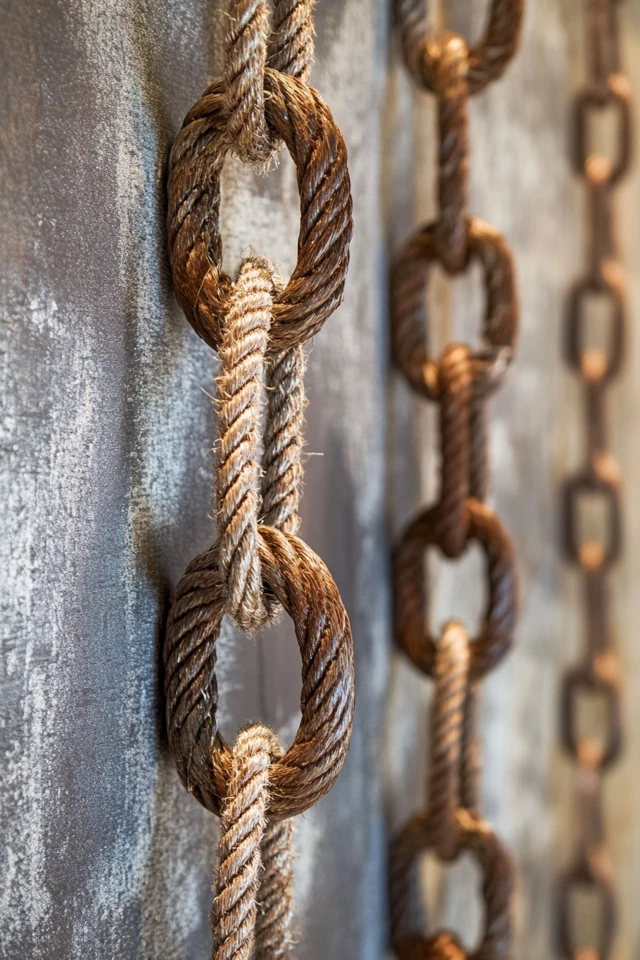
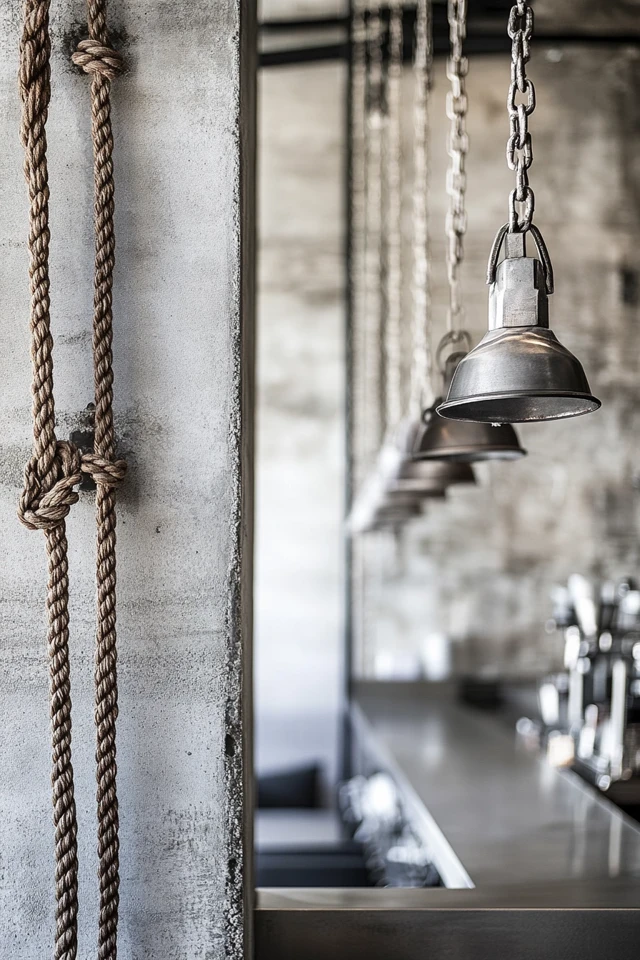
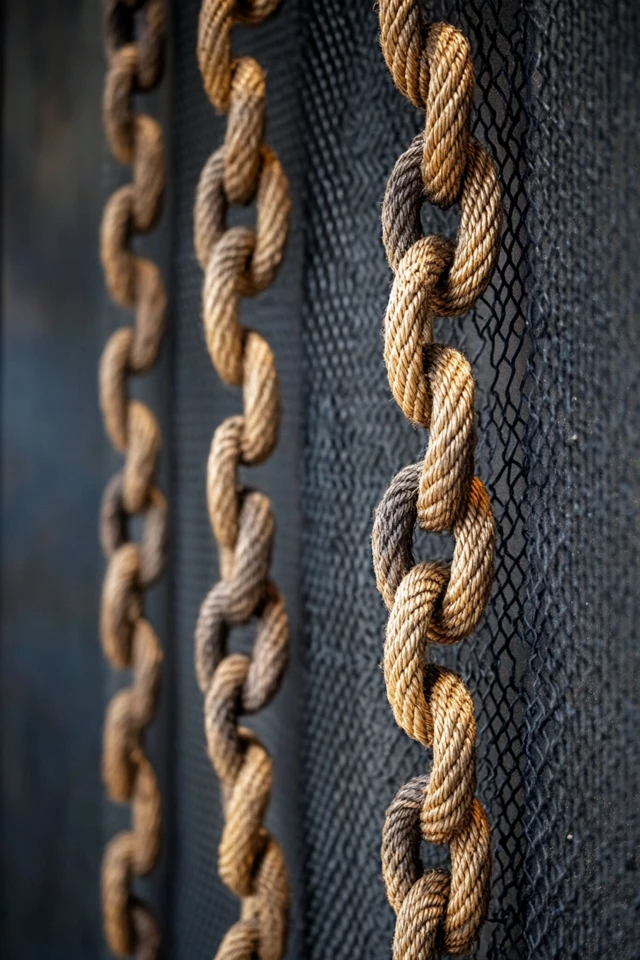
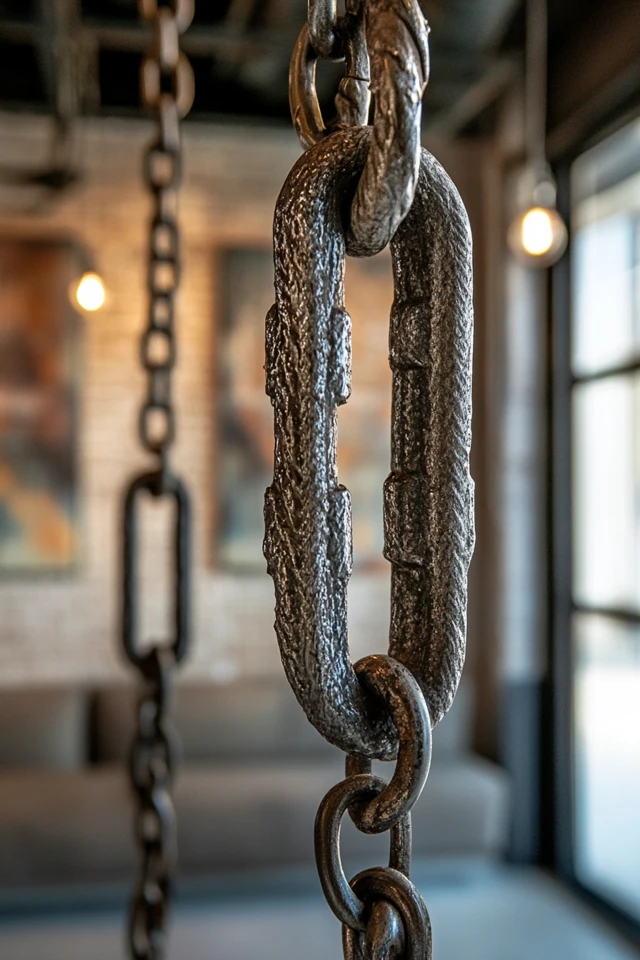
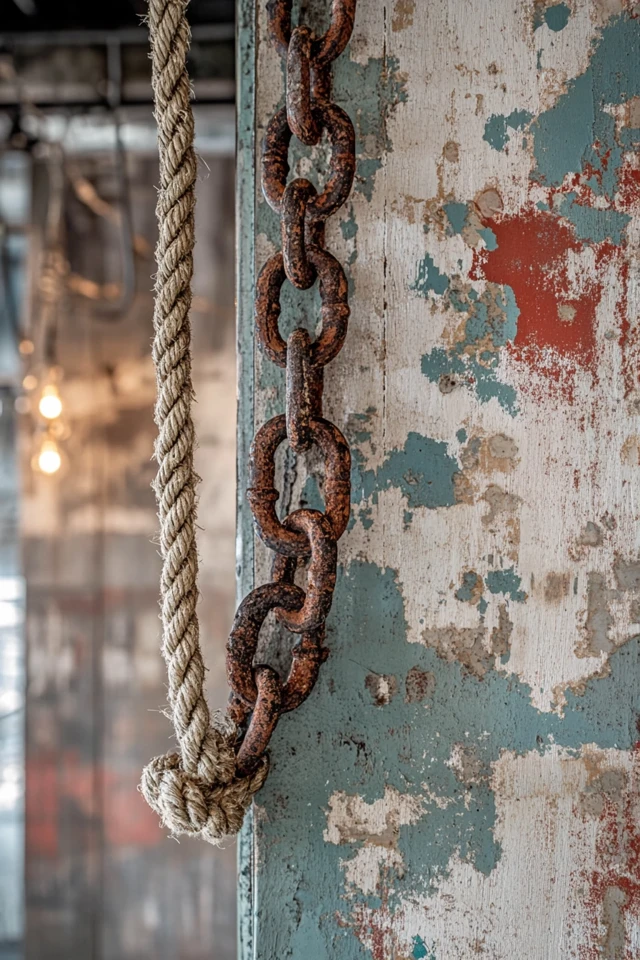
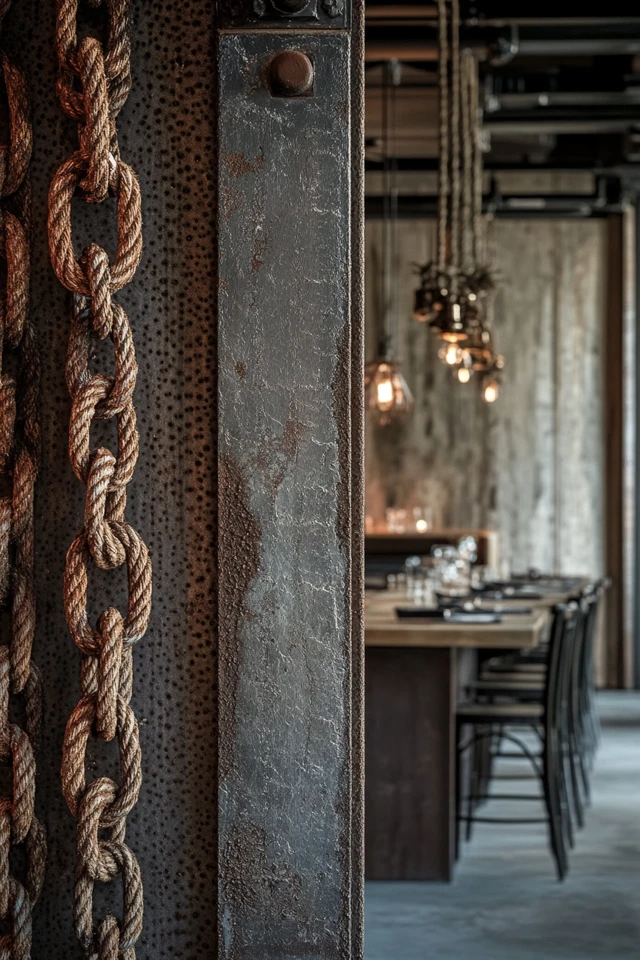
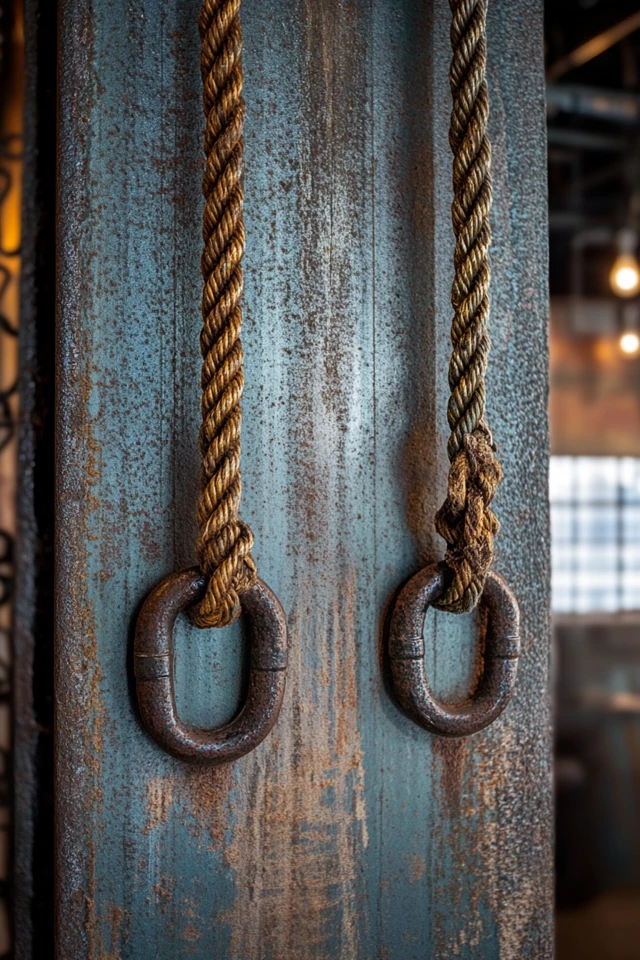
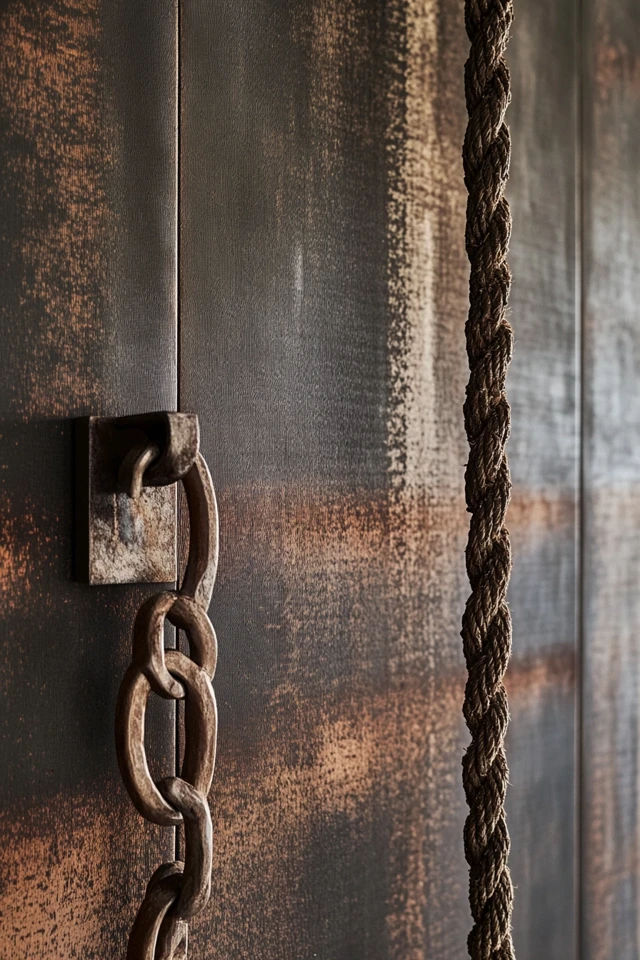
How to Balance Rope and Chains with Other Materials
Pair with Warm Textures
To prevent your space from feeling too cold or industrial, balance the ruggedness of rope and chains with softer textures. Use rugs, cushions, or curtains in natural fibers like wool, linen, or cotton.
Combine with Reclaimed Wood
Rope and chains pair beautifully with reclaimed wood furniture or accents. The organic texture of wood complements the raw look of these materials, creating a harmonious rustic-industrial vibe.
Add Pops of Greenery
Soften the hard edges of chains and the roughness of rope by adding greenery. Suspended planters or trailing vines bring life and freshness to industrial spaces.
Use Muted Colors
Stick to a muted color palette of grays, blacks, and earthy tones to maintain the industrial aesthetic. Let rope and chains stand out as natural accents within the design.
Conclusion
Rope and chains may not be the first materials that come to mind when designing an interior, but in industrial spaces, they shine. Whether used for lighting, shelving, or decorative accents, these materials bring authenticity, texture, and creativity to your home.
What I love most about using rope and chains is their ability to strike a balance between functionality and style. They’re not just decorative—they’re hardworking materials that have a purpose. And when paired with other industrial staples like exposed brick, concrete, and reclaimed wood, they create a space that feels cohesive, edgy, and full of character.
So, if you’re looking to elevate your industrial interior design, consider giving rope and chains a try. Whether you go big with chain-suspended lights or keep it subtle with rope tiebacks, these materials are sure to add depth and interest to your space.
FAQ
1. What type of rope works best for industrial design?
Thick natural ropes like jute, sisal, or manila are ideal for industrial design. Their rough texture and neutral tones fit perfectly with the aesthetic.
2. Are chains strong enough for shelving?
Yes, chains are incredibly strong and can support heavy shelving. Be sure to use the appropriate hardware and anchor them securely to walls or ceilings.
3. Can I use rope and chains in a small space?
Absolutely! Use them in small ways, like as curtain tiebacks, light fixture details, or decorative accents, to add industrial charm without overwhelming the room.
4. How do I clean rope and chains in my interior design?
For rope, use a vacuum or a damp cloth to remove dust and dirt. Chains can be cleaned with a soft cloth and mild soap. Be sure to dry them thoroughly to prevent rust.
5. Where can I source rope and chains for interior design projects?
You can find rope and chains at hardware stores, home improvement shops, or online retailers. For an authentic industrial look, consider salvaging materials from flea markets or antique stores.

